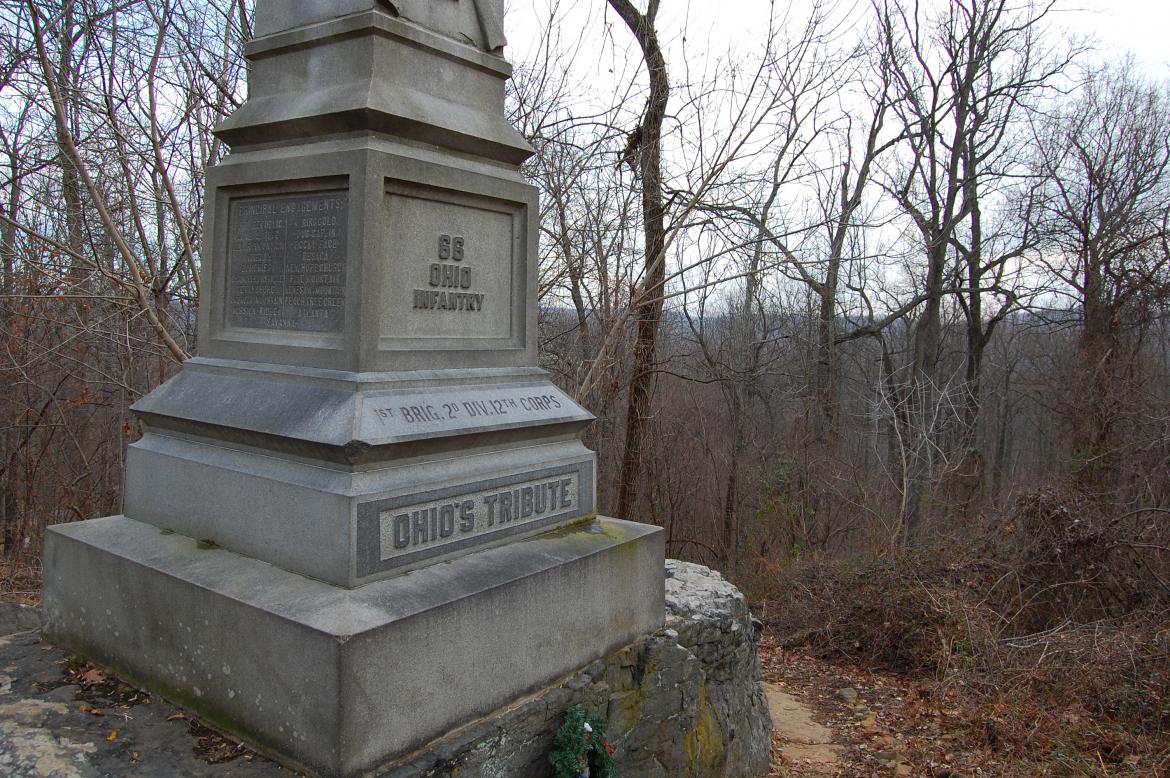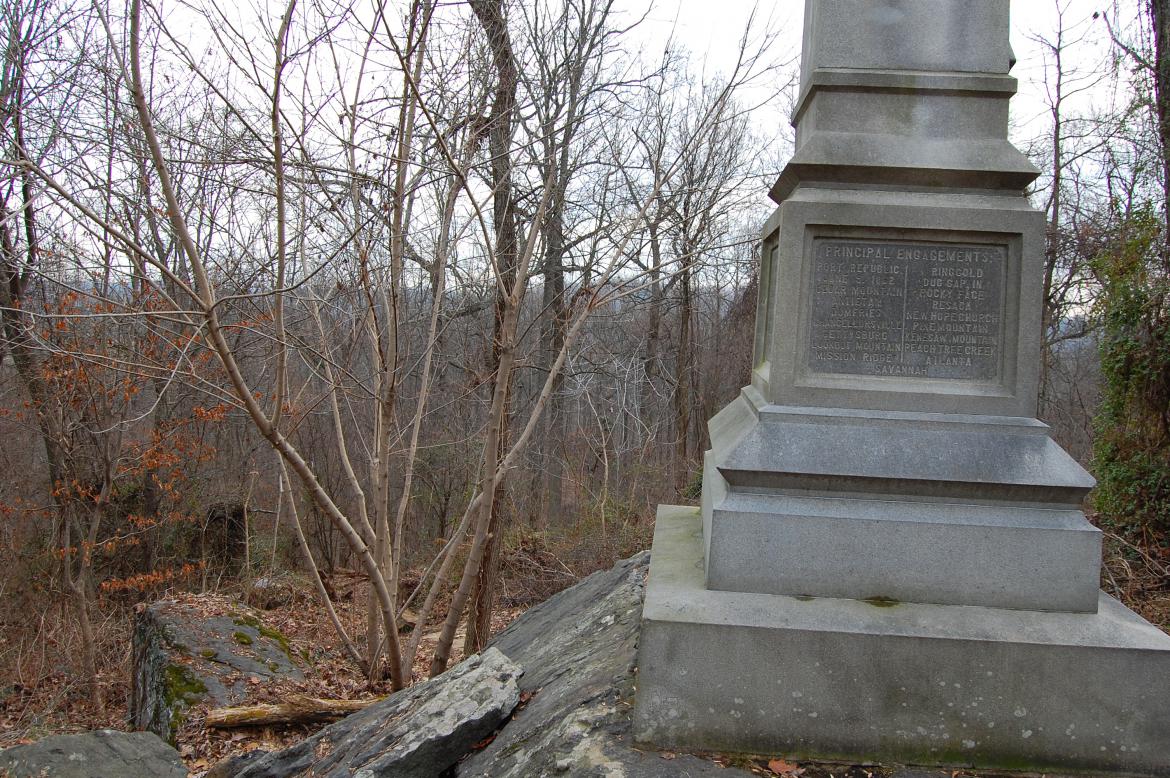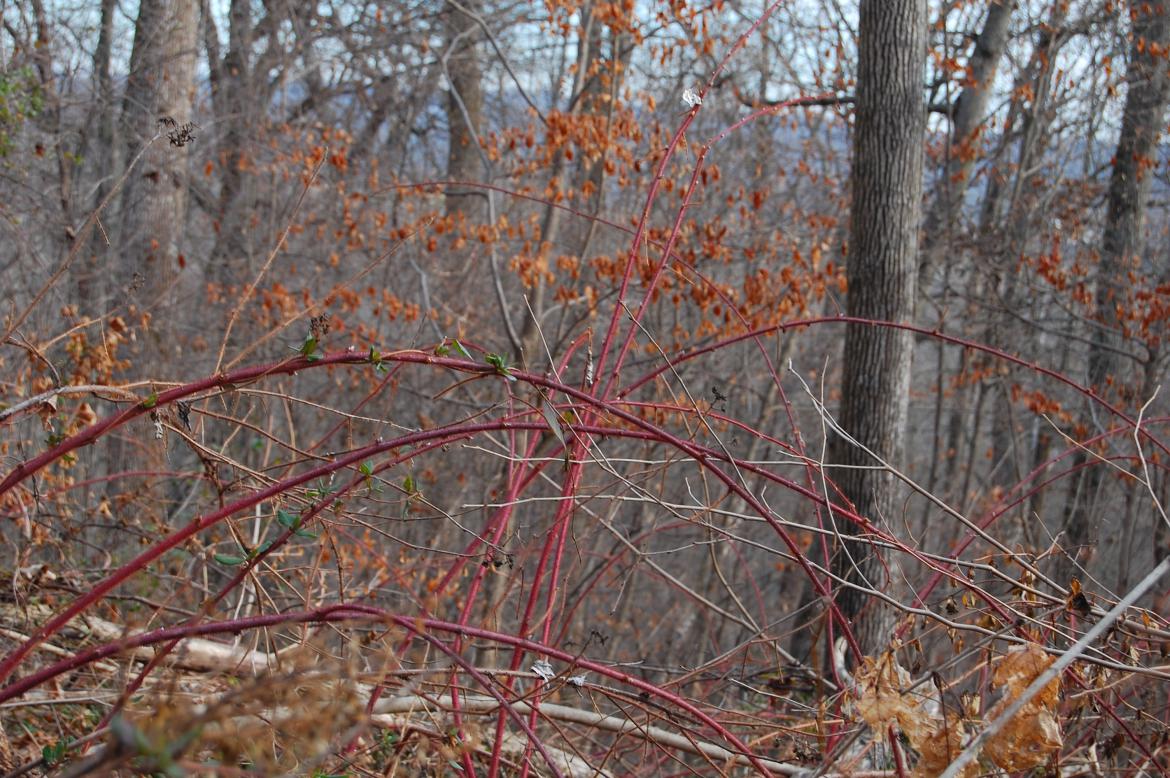After a long absence, the left flank marker to the 66th Ohio Infantry Regiment on the east side of Culp’s Hill was returned to its location by the National Park Service sometime this year. This view was taken facing east at approximately 10:00 AM on Monday, January 9, 2012.
With the leaves off the trees we found it an optimal time to show you how to navigate your way toward the 66th Ohio’s seldom visited left flank marker. One of the reasons that it has been seldom visited is because it has been gone for a time because it was knocked off its base. The National Park Service recently returned it. Yet even without the additional foliage it can still be a little difficult making our way to the marker over steep, rocky, and unmarked paths. We’ll also take a look at the misleading marker to Joshua Palmer. Thanks to Gettysburg Licensed Battlefield Guide Tim Smith for alerting us to the return of the 66th Ohio’s left flank marker.
A view of the east side of Culp’s Hill from the Culp’s Hill observation tower. Visible on the right is the monument to George Sears Green (dedicated in 1907). In the center by Slocum Avenue is the monument to Knap’s Pennsylvania Battery (dedicated in 1885). The path in the background leads almost straight ahead to the 60th New York Monument (dedicated in 1899). The same path also branches to the left towards the 66th Ohio Infantry Regiment monument (barely visible middle left of the photograph). The observation tower is also the location of our Culp’s Hill Panoramas. This view was taken facing east at approximately 10:00 AM on Monday, January 9, 2012.
To locate the left flank marker we’ll first go to the right flank marker, the monument itself, and Major Joshua Palmer’s marker. These markers are all located along the path shown ahead. This view was taken facing east at approximately 10:00 AM on Monday, January 9, 2012.
Here’s a closer view of Knapp’s Battery’s right flank marker at the beginning of the path. This view was taken facing east at approximately 10:00 AM on Monday, January 9, 2012.
The 66th Ohio Infantry Regiment monument and its right flank marker are now clearly visible on the path. This view was taken facing east at approximately 10:00 AM on Monday, January 9, 2012.
At Gettysburg the 66th Ohio Infantry Regiment was commanded by Lieutenant Colonel Eugene Powell. This view was taken facing east at approximately 10:00 AM on Monday, January 9, 2012.
A closer view of the right flank marker. The 66th Ohio Infantry Regiment arrived in a position just north of Little Round Top (probably Munshower’s Hill) at approximately 5:00 PM on July 1, 1863. This view was taken facing east at approximately 10:00 AM on Monday, January 9, 2012.
On the morning of July 2, 1863, the 66th Ohio was moved to Culp’s Hill and began constructing breastworks. On the morning of July 3, 1863, the 66th Ohio crossed the Union breastworks, and turned right to face south and enfilade Confederates on or charging up the slope of Culp’s Hill. This view was taken facing east at approximately 10:00 AM on Monday, January 9, 2012.
The monument to the 66th Ohio Infantry Regiment was supposed to be dedicated on September 14, 1887, which was Ohio Day at Gettysburg. 19 Ohio monuments were to be dedicated or rededicated on that day. This view was taken facing east at approximately 10:00 AM on Monday, January 9, 2012.
The New York Times account of Ohio Day at Gettysburg (published on September 15, 1887) mentions some monuments had not yet arrived, or been erected. This view was taken facing southeast at approximately 10:00 AM on Monday, January 9, 2012.
Those monuments that had not arrived or been erected by the dedication ceremonies included: 8th Ohio (stone still in the quarry), the 61st Ohio (not yet arrived), the 66th Ohio (not yet arrived), the 75th Ohio (not yet erected), and the 82nd Ohio (delayed). This view was taken facing southeast at approximately 10:00 AM on Monday, January 9, 2012.
The Ohio General Assembly passed the following act on May 4, 1885: An Act “to appropriate money to purchase lands upon which to erect a monument to the memory of the soldiers of Ohio who died upon the battle-field of Gettysburg.” $5000 was appropriated for this one monument. This view was taken facing east at approximately 10:00 AM on Monday, January 9, 2012.
However, on July 4, 1885, a meeting of Ohio veterans of the Battle of Gettysburg occurred. At this meeting, the veterans said the $5000 shouldn’t be spent on a single monument. It should: “provide for designating all the localities on the field where Ohio soldiers fought…” At the same meeting, a committee was appointed to assist the Adjutant-General of Ohio in locating where Ohio soldiers fought at Gettysburg. This view was taken facing east at approximately 10:00 AM on Monday, January 9, 2012.
On August 13, 1885 this committee met at Gettysburg. It consisted of representatives from 12 of the 19 Ohio units that fought at Gettysburg. A representative from the 66th Ohio was present. This view was taken facing east at approximately 10:00 AM on Monday, January 9, 2012.
From the 66th Ohio monument we’ll continue down this increasingly rocky path to the marker showing where Major Joshua G. Palmer was mortally wounded. This view was taken facing east at approximately 10:00 AM on Monday, January 9, 2012.
At the August, 1885 meeting in Gettysburg, the committee members inspected the battlefield, and decided that $2000 should be appropriated to erect a monument to each Ohio unit that was present at Gettysburg. This view was taken facing east at approximately 10:00 AM on Monday, January 9, 2012.
Here is the Palmer marker. At the next session of the Ohio General Assembly, the act to erect a monument to Ohio soldiers at Gettysburg for $5000 was amended. Now $35,000 was asked to procure land and erect a monument for each Ohio regiment, or battery at Gettysburg. The amended act was passed on April 21, 1886. This view was taken facing east at approximately 10:00 AM on Monday, January 9, 2012.
The downed tree visible in the foreground is the same witness tree we featured in August of 2011. This view was taken facing east at approximately 10:00 AM on Monday, January 9, 2012.
According to multiple sources, Major Palmer was near the left flank of the 66th Ohio when a Confederate bullet entered his left lung. Four privates from his old company took him back up the slope to the earthworks. Private John Houtz wrote: “I saw he was breathing through the hole the ball had made. I took a fine silk handkerchief I happened to have and wet it from my canteen and pressed it upon the wound. Palmer uttered, ‘Oh, that did me so much good,’ then said encouragingly, “Stay with them, boys! I will soon be back with you.” Palmer died the next week. This view was taken facing northeast at approximately 10:00 AM on Monday, January 9, 2012.
For more information on Joshua Palmer see Denny Forwood’s May 2009 post as part of his Gettysburg Dentist Stories series. This view was taken facing northeast at approximately 5:00 PM on Friday, May 15, 2009.
From the Palmer marker, if you look closely, you can see in the distance the left flank marker to the 66th Ohio. This view was taken facing east at approximately 10:00 AM on Monday, January 9, 2012.
A closer view of the flank marker through the trees (center of photograph). This view was taken facing east at approximately 10:00 AM on Monday, January 9, 2012.
We’ll now turn around on the path and go back to the 66th’s right flank marker. This view was taken facing west at approximately 10:00 AM on Monday, January 9, 2012.
From here we can see another path available to us, which although not marked, will allow us to slowly work our way through the brush to the left flank marker. This view was taken facing east at approximately 10:00 AM on Monday, January 9, 2012.
The Ohio Commission members returned to Gettysburg on July 15th and 16th, 1886 and again inspected the positions occupied by Ohio units during the battle. This view was taken facing east at approximately 10:00 AM on Monday, January 9, 2012.
The Commission decided that not only should each Ohio unit have its own monument, but also “that not two or more of these memorials should be of the same pattern or design, and that none of them should be duplicates of any of the memorials already erected on the field.” This view was taken facing east at approximately 10:00 AM on Monday, January 9, 2012.
On September 7, 1886 the Ohio Commission sent a circular inviting proposals for the erection of the monuments. Each infantry monument and the 6th Ohio Cavalry monument would cost $1500 each. The 1st Ohio Cavalry’s monument (only two companies at Gettysburg) and the four artillery batteries’ monuments would be $500 each. This view was taken facing east at approximately 10:00 AM on Monday, January 9, 2012.
Be sure to watch out for the sticky bushes/brambles/thorns which are found in increasing numbers here. This view was taken facing east at approximately 10:00 AM on Monday, January 9, 2012.
All bids were to include the “tablets marking the right and left positions of the several regiments and batteries,” which today we call the flank markers. This view was taken facing east at approximately 10:00 AM on Monday, January 9, 2012.
If we turn around from this new path we can again see the 66th Ohio Regiment monument and its right flank marker. This view was taken facing west at approximately 10:00 AM on Monday, January 9, 2012.
All the bids were to be opened at the Commission’s office (it ended up in the Senate Chamber in the State Capitol) in Columbus, Ohio at noon on Thursday, October 14, 1886. And the Commission then changed its collective mind and decided that each memorial should cost the same amount, $1500. This view was taken facing east at approximately 10:00 AM on Monday, January 9, 2012.
The meeting was attended by veterans of the different Gettysburg units. All units were represented except for the 6th Ohio Cavalry, Dilger’s Battery, and Heckman’s Battery. This view was taken facing east at approximately 10:00 AM on Monday, January 9, 2012.
We’ll press on directly away from the observation tower, going down the hill. This view was taken facing east at approximately 10:00 AM on Monday, January 9, 2012.
At the Commission meeting on October 14, 1886, “many of the manufacturers of monuments were also present, either in person or by agents, and about six hundred designs, in all were presented.” The Commission meeting continued through October 15th and 16th with the veterans working to pick out the design that they liked best for their monument. This view was taken facing east at approximately 10:00 AM on Monday, January 9, 2012.
From here we can begin to make out the left flank marker in the distance. This view was taken facing east at approximately 10:00 AM on Monday, January 9, 2012.
The representatives of the 66th Ohio chose “Design No. 5, of J. McElwaine, Springfield, Ohio.” This view was taken facing east at approximately 10:00 AM on Monday, January 9, 2012.
Contracts for the Ohio monuments were awarded and negotiated. The 66th Ohio Monument’s contract was finalized on March 3, 1887. This view was taken facing east at approximately 10:00 AM on Monday, January 9, 2012.
Looking to our right (west) we again see the 66th’s monument. This view was taken facing west at approximately 10:00 AM on Monday, January 9, 2012.
The third paragraph of the contract stated the following: “Said party of the first part further agrees to provide and erect flanking posts not less than two in number, marking the right and left flanks of the said 66th Ohio Regiment during said battle of Gettysburg; all of said posts to be placed in such positions as said Commission shall designate, and to be manufactured of selected (whatever material they chose), in accordance with the specifications for said posts hereto annexed.” This view was taken facing east at approximately 10:00 AM on Monday, January 9, 2012.
The fourth paragraph of the contract states: “It is further stipulated and agreed by said party of the first part that said monument and flanking posts shall be manufactured and erected complete on the battle-field of Gettysburg, as specified in this contract and the accompanying designs and specifications, not later than the first day of September, A.D. 1887, and that when said monument and posts shall be completed they shall be set up at the works for inspections and approval should the said Commission so require.” This view was taken facing east at approximately 10:00 AM on Monday, January 9, 2012.
“The terms ‘right and left,’ herein used, shall be held to mean right and left hand to the spectator facing the monument in front.” (Editor’s Note: that didn’t happen very often. Left and right usually means the direction of the unit facing its enemy.) This view was taken facing east at approximately 10:00 AM on Monday, January 9, 2012.
“The flanking posts shall consist each of but one piece, and shall extend not less than two and a half feet below, nor less than twenty inches above the natural surface of the ground. The flanking posts shall be manufactured of the best quality of (insert material here), and shall match the monument in color, quality of material, and workmanship.” This view was taken facing east at approximately 10:00 AM on Monday, January 9, 2012.
On page 17 of the Commission report we ran across this interesting item: “At the request of the committee of the Sixty-sixth Infantry a tablet was granted marking the position held by that regiment in advance of the Union breastworks on Culp’s Hill, July 3, 1863. This tablet was manufactured and erected by Messrs. Frederick & Field, or Quincy, Mass. It is composed of Quincy granite, and cost $55.00.” The only tablet marking this description is the Palmer tablet. This view was taken facing south at approximately 10:00 AM on Monday, January 9, 2012.
On page 20 of the Commission report is this paragraph about the 66th Ohio’s monument and its location: “Near the summit of Culp’s Hill, just outside the Union breastworks. After having taken an active part on July 2, in establishing and holding the line further to the right, the Sixty-sixty, at daybreak July 3, was ordered to move outside the Union breastworks and make a demonstration on the enemy’s right flank. THE MONUMENT INDICATES THE POINT AT WHICH THE CROSSING TOOK PLACE, AND WHERE THE RIGHT OF THE LINE WAS ESTABLISHED. It stands on one of the huge granite boulders which are embedded on the hillside, and although surrounded by forest trees, commands a fine view over the country in the direction of Benner’s Hill.” So the monument, which is frequently in the center of the battle line is near the right flank of the battle line. This view was taken facing east at approximately 10:00 AM on Monday, January 9, 2012.
On page 36 of the Commission report: “The tablet marking the center of the line held by the regiment outside the Union breastworks July 3, rests upon a large granite boulder and is thus inscribed: 66th O.V.I., July 3, 1863. HERE MAJOR J.G. PALMER FELL MORTALLY WOUNDED…” This view was taken facing east at approximately 10:00 AM on Monday, January 9, 2012.
It appears to our reading of the reports that the monument was placed where it was because the large rock was very useful to accommodate the large structure. However, that placed the monument on the right side of the line, and the regiment’s veterans probably not only wanted to honor Major Palmer, they wanted to show the center of the battle line where the colors stood. Thus the creation of the Palmer marker. However, if Palmer was on the left flank of the regiment, then his marker should be down here near the left flank marker. So the placement of the Palmer marker was probably a historically misleading compromise between those who wanted to honor Palmer, and those who wanted to mark the center of the battle line. This view was taken facing southwest at approximately 10:00 AM on Monday, January 9, 2012.
As we previously stated, the monument and the flank markers arrived too late for the dedication ceremonies, but arrived soon after. They were erected “complete, or nearly so, during the dedication week” (page 18). This view was taken facing south at approximately 10:00 AM on Monday, January 9, 2012.

















































